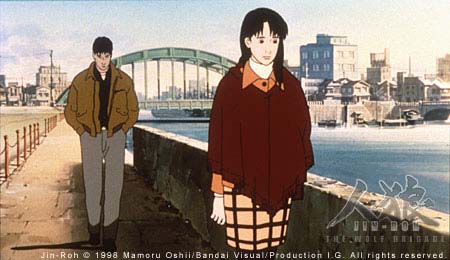


Got Game?

NEARLY 60 YEARS after the end of World War II, movies about the war look at individual stories, unsung heroes and psychological impacts. Anime joins that genre with "Jin-Roh: The Wolf Brigade." ‘Jin-Roh’
sketches twists in tale
of postwar JapanDRAWN & QUARTERED
By Wilma Jandoc
wjandoc@starbulletin.comThe movie takes place in Japan about 10 years after World War II, but in an alternate reality: Instead of America, Nazi Germany has its hold over Japan. The country is reorganized, political tensions over the new constitution abound and terrorist groups have sprung up. The largest and most powerful is The Sect.
Over time, as people look to rebuild the country, The Sect is pushed to the fringes of society and goes underground. The group is still dangerous, though, and the counterterrorist Capital Police are created to keep The Sect in check.
All this is told in the movie's opening scenes in a several-minutes-long collage of still shots with monotonous narration that make it easy to lose the storyline.
The anime eventually focuses on a high school girl who is one of The Sect's "Red Riding Hoods," girls who help smuggle weapons. She delivers one bomb during a protest and is making her way through the sewers with another when the elite armored Special Unit, a division of the Capital Police, begins pursuing her and other Sect members.
Kazuki Fuse is the first to come upon the girl, but he doesn't want to shoot her. Taking advantage of his indecision, the girl sets off the bomb, killing herself and cutting power to a good part of Tokyo.
The incident is a political fiasco, and Fuse is sent into retraining. Factions are trying to disband the Special Unit and latch onto this, and Fuse, as justification.
But others are working to keep the unit alive, including a rumored rogue brigade within the unit calling themselves "The Wolves."
The dead girl, Nanami, begins to haunt Fuse as he struggles to come to terms with her death. He comes in contact with her older sister, Kei, and the two begin a relationship of sorts.
But the couple is constantly in danger as political enemies work to use Fuse in any way possible to discredit the Special Unit.
"Jin-Roh" is as convoluted as one of scriptwriter Mamoru Oshii's other well-known anime, "Ghost in the Shell." Part psychological, part political, this anime is different in that it has as many twists as the "Mission Impossible" movies.
The anime intersperses the original, more grotesque version of the fairy tale "Little Red Riding Hood," a favorite analogy in political commentary, to explore the theme of "the beast within."
The animation is excellent, with realistic fluidity of movement.
The plot is absorbing, though hampered by its slow and information-laden beginning, and its complex layers make it difficult to grasp.
As for the alternate reality, it adds little to the plot other than bringing in recognizable German symbols such as Volkswagens.
Despite the anime's psychological angle, there isn't much character development. Fuse's personal- ity remains aloof, while Kei's psychology goes unexplored. Yet the film succeeds in delivering sympathetic characters.
Shorn of political intrigue, "Jin-Roh" is the usual tale of lost innocence and the primal instinct of survival in a world turned upside-down by war. But it injects a dose of the softer side of life through Fuse and Kei, who struggle to hold on to their humanity as they are swept away by the desperate drive to survive.
"Jin-Roh" is not rated and has scenes of bloody violence. It is currently showing at Wallace Theatres at Restaurant Row.
Wilma Jandoc covers the universe
of video games and anime for the
Star-Bulletin. She can be emailed at
wjandoc@starbulletin.com